No trip to the Cowboy State is complete without attending one of the classic Wyoming rodeos.
As the official state sport, rodeos of all sizes can be found to the north, south, east and west. From the 10-day “Daddy of ’em All®” – Cheyenne Frontier Days – to the nightly rodeo Cody hosts throughout the summer, there’s no shortage of rodeos in Wyoming. There’s more to this thrilling sport than meets the eye; rodeo scoring is based on a handful of skills and technicalities, and if you get a feel for them before you go, you’ll get even more out of the experience.
If you’re interested in checking out Wyoming rodeos on your next getaway but are unfamiliar with the sport, you might want to dig in before they saddle up. Let’s begin at the beginning. If you’re asking yourself: “What is a rodeo?”, we’ve got your answer.
Table of Contents
- What Is a Rodeo?
- Common Rodeo Events
- What to Wear at a Rodeo
- Popular Rodeo Animals
- Team Wyoming Rodeo Program
What Is a Rodeo, Anyway?
By definition, a rodeo is “a public performance featuring bronco riding, calf roping, steer wrestling, and Brahma bull riding” or a competition that features some of those elements. Historically, the rodeo events we know and love today date back to the 1800s and were first introduced to the states by vaqueros, or Mexican ranch hands. American cowboys embraced some of their traditions as the Western World became more intertwined with our neighbors south of the border, and the rodeo was born stateside.
The sport’s popularity spread west and eventually nationwide, but Wyoming rodeos have always been special, beginning with Cheyenne Frontier Days in the late 1890s. This mammoth rodeo and frontier life celebration is the oldest and largest in the state and is still a visitor must-see today. The rodeo’s roots were further established over the next 20 years, partly due to William F. “Buffalo Bill” Cody and the city that shares his name. While Buffalo Bill took the bucking broncos in his famous Wild West Show on the road, Cody became Wyoming’s rodeo capital after his passing. The state’s heritage as a pivotal part of Western settlement makes it a proud haven for the cowboy sport.
By now, we’ve answered two pivotal questions: What is a rodeo, and why is it essential to the history of Wyoming? Now, it’s time to explore what to wear to a rodeo so you will know how to properly gussy up for the show.
Excited to see a Wyoming rodeo for yourself? Visit our events page to find a rodeo near you.
What Are the Most Common Rodeo Events?
The events are laid out in a set order that alternates timed and rough stock competitions to use each side of the ring best. The most common events you will find at Wyoming rodeos are:
- Bareback horse/bronc riding
- Bull riding
- Steer wrestling
- Team roping
- Saddle bronc riding
- Tie-down roping
- Barrel racing
- Breakaway Roping
Now that you have a basic run-down of the events, take a deeper dive into how they are run so you know what to expect before entering the grandstands.
Bareback Horse & Bronc Riding
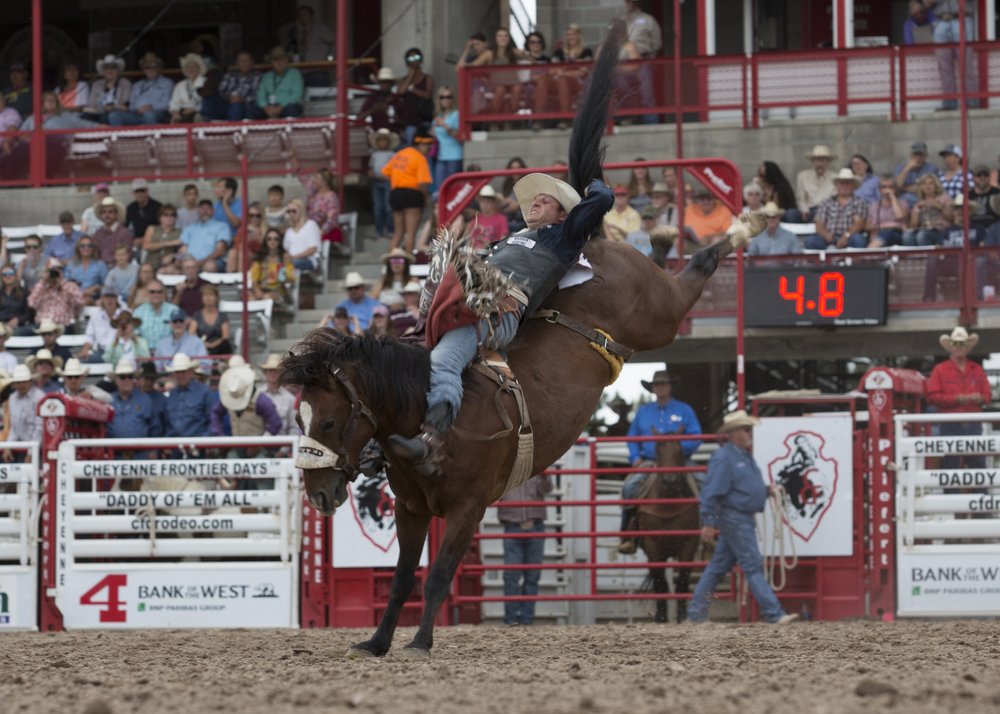
The rodeo scoring for this event hinges on the performance of both the bucking horse and rider. The cowboy has a single handhold and must ride for eight seconds. He must have both spurs touching the horse’s shoulder as the animal jumps from the chute. This action is called “marking out,” and cowboys who fail to do this face disqualification.
During the ride, the cowboy pulls his knees up as the bronc bucks, rolling his spurs up the horse’s shoulders. He straightens his legs as the horse descends and returns his spurs to the point over the horse’s shoulders as he prepares for the next jump. Bareback riding is considered the most challenging event due to the injuries and long-term damage sustained by participating cowboys.
Pro tip: “Bareback Horse Riding” and “Bareback Bronc Riding” are interchangeable terms. The only difference is that a bronc refers to an unbroken horse that has been selected because it is resistant to training, thus upping the element of danger.
Bull Riding
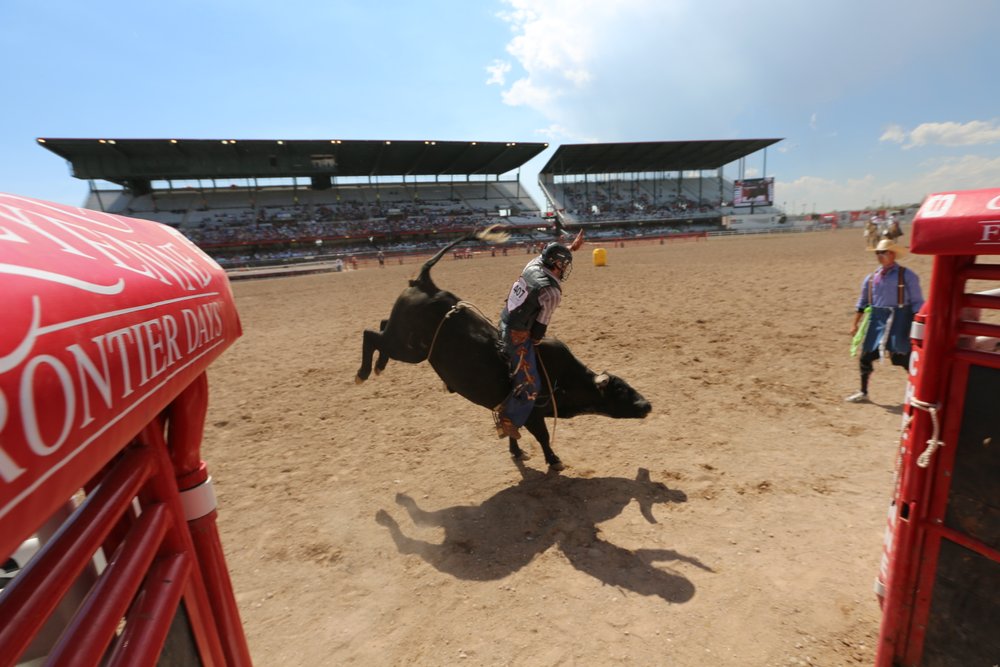
Riders compete aboard a bull weighing one ton or more and must remain seated for eight seconds. Similar to bareback riding, cowboys have a single handhold and try to stay forward, or “over his hand,” to avoid being whipped forward when the bull bucks.
Judges watch for good body position and consider factors such as using the free arm and the cowboy’s ability to match the bull’s moves. Four judges evaluate each ride, and 50 percent of the score is based on the contestant and the other 50 percent on the bull’s performance. A rider faces disqualification if he touches the bull, himself or the equipment with his free hand or gets bucked off.
Steer Wrestling
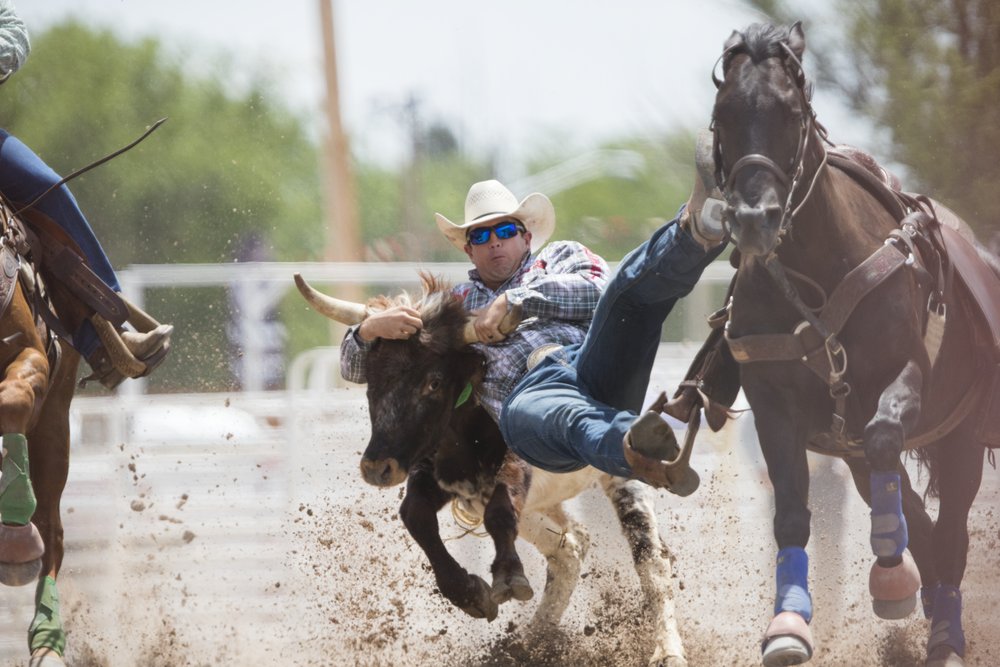
A successful steer wrestler combines strength with leverage for this timed competition. The steer wrestler is on horseback and remains behind a barrier to give the steer a head start. Steer wrestlers – or “bulldoggers” – who leave too quickly receive a 10-second penalty called “breaking the barrier.” A “hazer” – another cowboy on horseback – stays on the opposite side of the steer to keep him running in a straight line.
When the bulldogger’s horse draws even with the steer, the cowboy eases down the horse’s right side and grabs the steer by the horns. Once he has the horns, he digs his heels into the dirt to slow the steer. He then turns the steer, lifts the animal’s right horn and pushes down with his left hand to try to tip over the steer. Contestants who fail to bring the steer to a stop or change the direction of the steer’s body before the throw are disqualified. The clock stops when the steer is on his side, with all four legs pointing in the same direction.
Team Roping
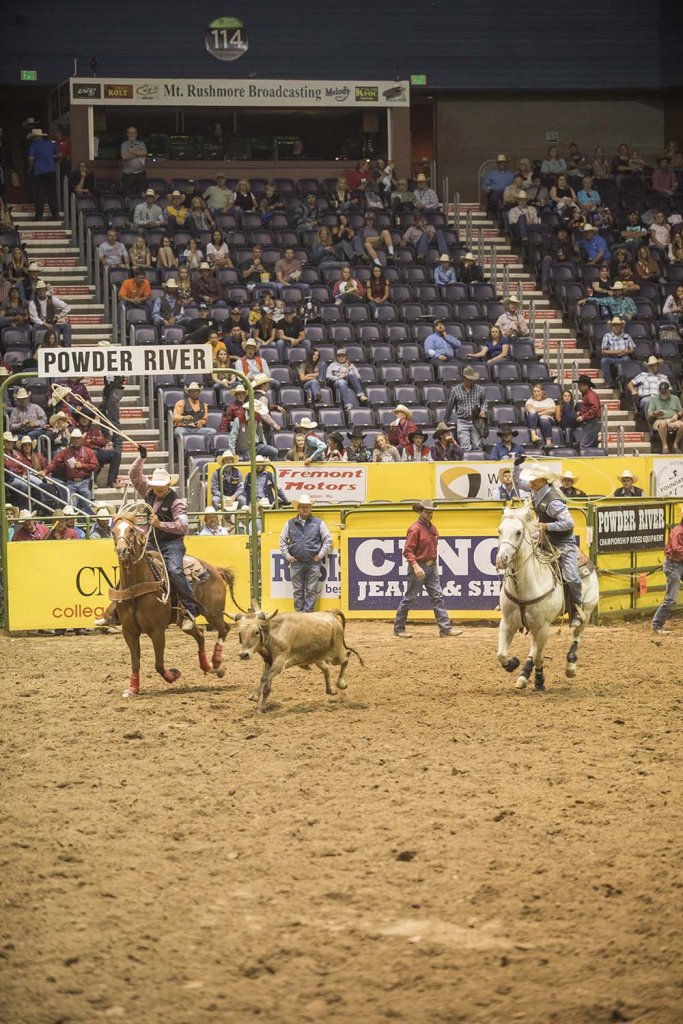
As the only team event at professional rodeos, successful team roping requires high coordination between two cowboys – a header and a heeler – and their horses. Similar to tie-down roping, an event held later in the rodeo, team roping begins with the steer getting a head start before the riders give chase. The header pursues the steer (with the heeler close behind) to rope the steer around both horns, one horn or the neck.
Once this “catch” is made, the header turns the steer to expose the animal’s hind legs to the heeler. The heeler works to rope both legs, and the clock is stopped when the ropes are no longer slack and the horses face each other. The team receives a 10-second penalty if they do not give the calf a proper head start. Additionally, if the heeler only ropes one leg, the team is assessed a five-second penalty.
Saddle Bronc Riding
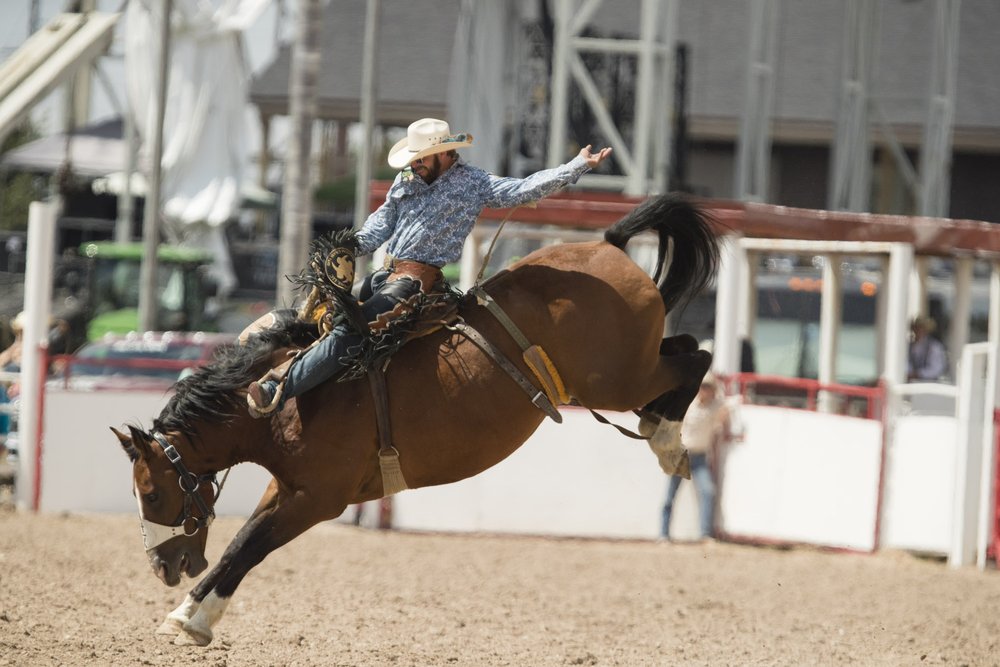
This classic rodeo event started during the early days of the Old West when cowboys tried to decide who had the best style when riding an untrained horse. Today’s saddle bronc riders begin each ride with their feet over the bronc’s shoulder, or “marked out,” to give the horse the advantage and ride for eight seconds. Riders who synchronize spurring with the horse’s bucking motion receive higher scores.
Scoring is also based on the cowboy’s control throughout the ride, the length of his spurring strokes and how hard the horse bucks. Disqualification results if the rider is bucked off, his foot comes out of the stirrup, he drops the rein or fails to have his feet in proper “mark out” position at the start of the ride. Riders are also disqualified if they touch the horse, themselves or the equipment with their free hand.
Tie-down Roping
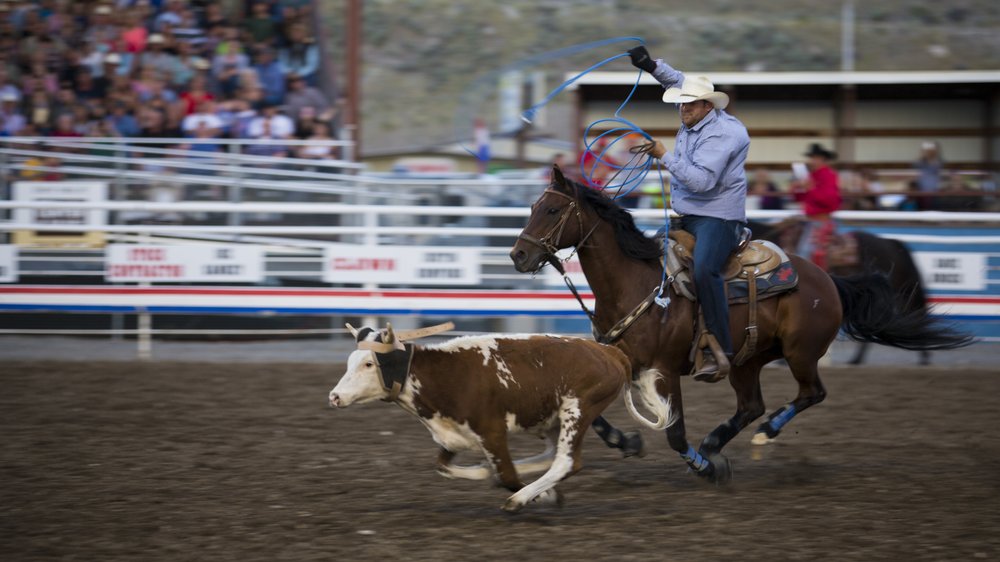
Calves were roped on early ranches for branding and to administer medication. Tie-down roping today involves teamwork between horse and rider, with the calf getting a head start before the horse and rider give chase. The cowboy receives a 10-second penalty if he does not give the calf a proper head start. The cowboy’s horse stops when the cowboy ropes the calf around the neck, effectively holding the animal. The rider dismounts and runs to the calf, flips him on his side and ties any three legs together using a “piggy string” the cowboy carries with his teeth.
Once the cowboy completes the tie, he throws his hands in the air to signal the judges. He then remounts his horse and allows the rope to become slack. The contestant is disqualified if the calf kicks loose within six seconds.
Barrel Racing
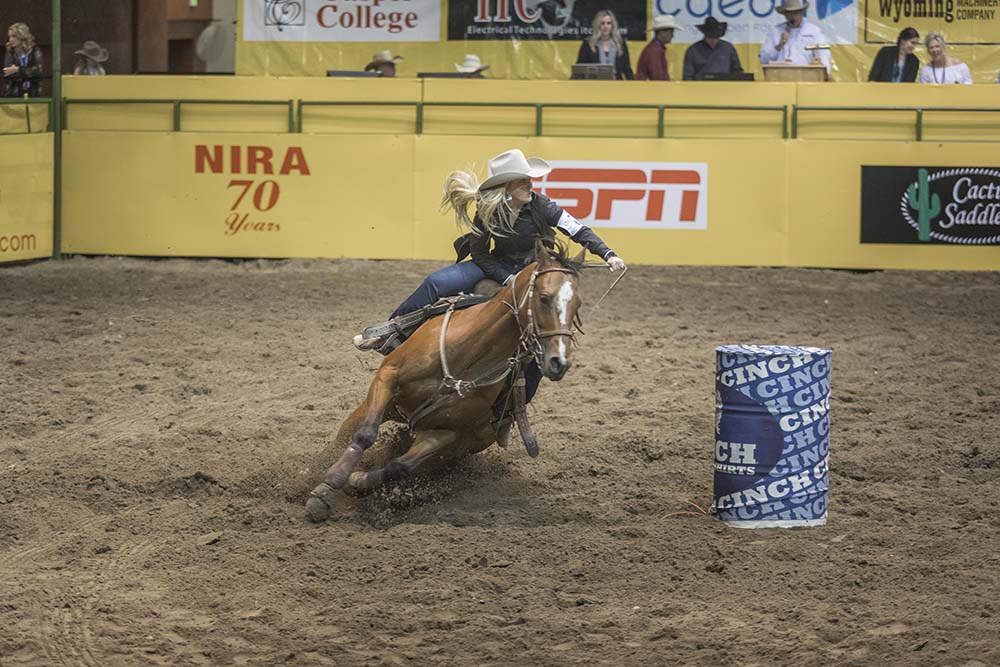
In this event, the cowgirl and her horse enter the arena at full speed, triggering an electronic eye that starts the clock. Horse and rider run a cloverleaf pattern around three barrels before they gallop from the arena, tripping the clock to stop as they exit. Contestants may touch or even move a barrel during the run but receive a 5-second penalty for overturning a barrel. This event is timed and cowgirls strive for the fastest time.
Breakaway Roping
This popular style of calf roping is similar to tie-down roping but with a few key differences. Before the event, a rope is tied around the calf’s neck on one end, with the other attached to a barrier across the horse and rider. The barrier material is designed to “break away” once the calf receives its necessary head start, and then the rider may charge in.
The calf must be roped with what’s known as a “bell-collar catch;” as it is not flipped or tied, the score hinges entirely on the rider’s speed.
Cowgirls primarily perform this event, and they can receive time penalties for catching the calf in any other type of hold or “breaking the barrier” and not waiting until the calf is far enough away to begin.
All-Around Cowboy
Cowboys who participate in two or more events at the rodeo are eligible for recognition as the All-Around Cowboy Champion. The PRCA world all-around champion is named at the National Finals Rodeo each year and is considered the most versatile athlete in professional rodeo.
Bullfighting – More Than Clowning Around
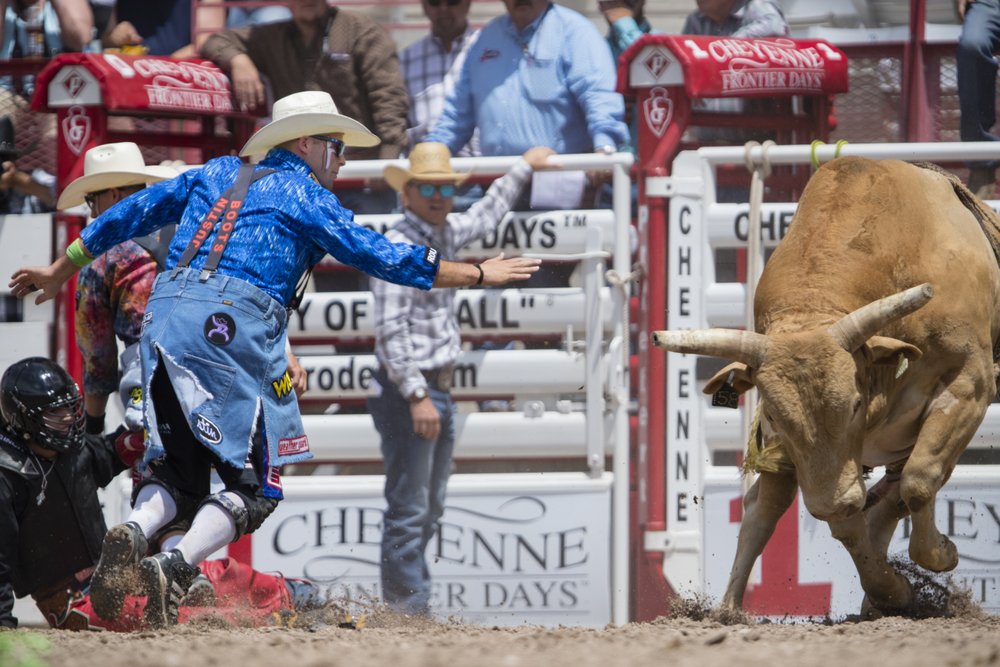
You can’t miss bullfighters with their face paint, baggy pants and entertaining antics. They’re talented and funny, but their main job is to save cowboys’ lives. Bullfighters are sometimes called rodeo clowns and spring into action whenever a bull throws a cowboy to divert the animal’s attention away from the rider.
These athletes understand the psychology behind bullfighting, taking time to study the individual animals and the cowboys who ride them. Bullfighters can often prevent threatening situations from becoming dangerous – without the audience realizing the risk involved. It’s all part of their job.
What to Wear to a Rodeo
Curious about what to wear to a rodeo that will make you feel cowboy chic? Well, the first thing you need to know is that there is no required dress code for the audience. The rodeo riders have specific style guidelines that they must adhere to, but that does not extend to the fans in the grandstands, so you are more than welcome to wear whatever makes you feel confident and comfortable.
That said, many audience members take the opportunity to put on their Western best and dress like the cowpokes they’re there to see. While you’re not obligated to invest in a rodeo outfit, if you’re rooting through your closet searching for the perfect look, here are some suggestions:
- Cowboy hats – From the vintage Gambler to the classically popular Cattleman, there’s no better place to sport your hat than the rodeo.
- Cowboy boots – Similar to the cowboy hat, many people bust out a pair of boots to match their favorite riders. These extend from Western style to English riding boots and can be as adorned as you’d like, from standard styles to wild colors and rhinestones.
- Jeans – Struggling to figure out what to wear to a rodeo? Denim is always the secondary star, as most cowboys and cowgirls have to rock a pair of jeans while competing. However, if you prefer a denim jacket or shirt, that is also right on brand.
- Dress shirts – The rodeo serves as a fancy night out for many folks, and sometimes that involves putting on a shirt that is among your Sunday best. Button-up or snap-up, a collared shirt is always a fine choice.
- Casual sundresses – Whether pairing cowboy boots with something soft and pretty or looking for a way to stay cool on a hot summer day, a casual cotton dress can be just what you’re looking for.
- Other essentials – Speaking of a hot summer day, the rodeo is a warm-weather sport, so there is an excellent chance you will take one in out in the heat. Consider packing extra sunscreen, sunglasses and even an umbrella to prepare for anything. Are you catching an evening rodeo? Bring a jacket in case it gets chilly when the sun goes down.
Now that you know what to wear to a rodeo you can be prepared for when yo arrive.
Popular Rodeo Animals
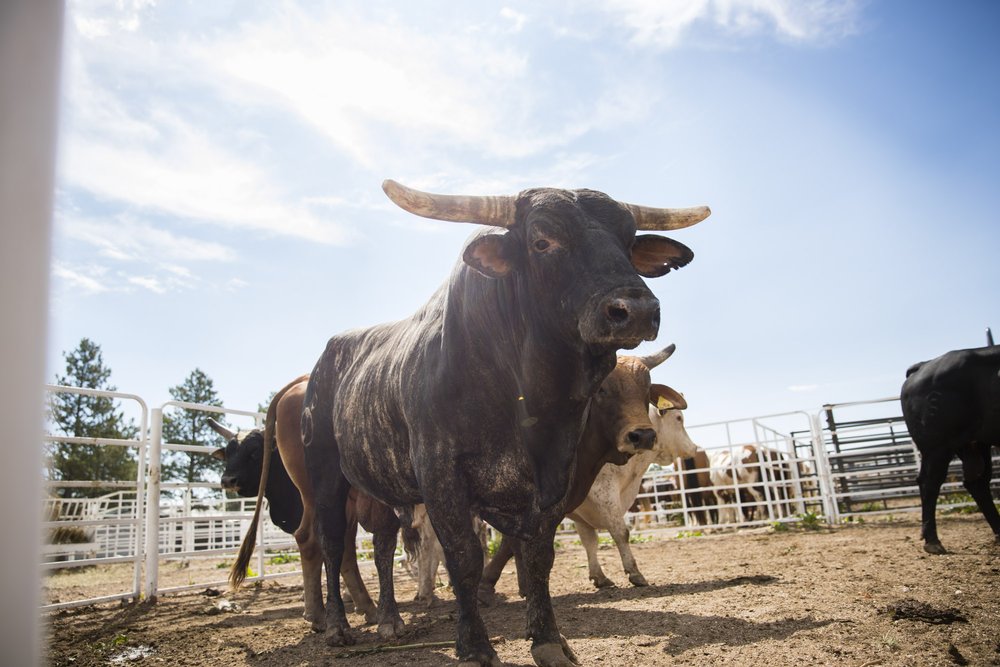
Rodeo animals – horses and cattle – are valuable stock worth tens of thousands of dollars. In many instances, these animals:
- Come from ranches that have earned reputations for their proven performance.
- Provide a tremendous challenge for even the most seasoned riders.
- Are raised and cared for at ranches that take great pride in their stock.
- Receive the attention they need to perform at top levels every time they enter the chute.
The PRCA recognizes top rodeo stock with awards such as the “Bucking Horse of the Year” and the “World Champion Bull.”
Team Wyoming Rodeo Program
As The Cowboy State, Wyoming sponsors professional cowboys and cowgirls as part of Team Wyoming. The team, which includes professional and collegiate athletes, reinforces the sport’s continuation while promoting Wyoming and its cowboy heritage. Team Wyoming includes PRCA and WPRA members who have qualified for or participated in the Wrangler National Finals Rodeo in Las Vegas within the past five years.
Team Wyoming members must enter and compete throughout the season to win a world title. They must also be Wyoming residents or natives and maintain a part-time Wyoming residence. You’ll see team members at various events, greeting fans and working with the media. Members of Team Wyoming are counted among the world’s top rodeo competitors.
For more on rodeo events and scoring, check out the Rodeo Rules Made Simple, videos created by Cheyenne Frontier Days.